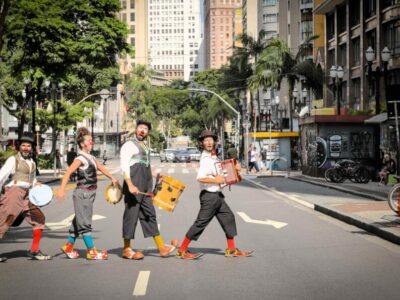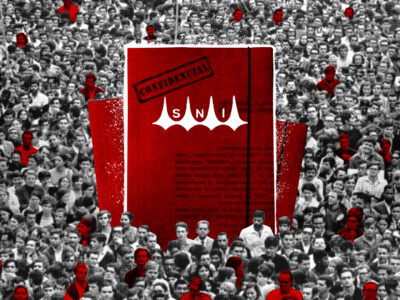
Instrutor Uday Raj Aaley (extrema direita) com estudantes da língua kusunda. Foto de Uday Raj Aaley. Usada sob permissão.
Kusunda, antigo grupo étnico indígena caçador-coletor do centro-oeste do Nepal, tem um idioma único que não está relacionada a nenhum outro idioma do mundo. O pesquisador e escritor Uday Raj Aaley, juntamente com a pessoa especializada e única falante fluente de kusunda, Kamala Sen Khatri, está em uma missão para reviver o idioma, antes considerado moribundo.
O povo kusunda, também conhecido como mjehaq ou gemjehaq (rei da floresta), tem menos de 200 membros vivendo em Dang Deukhuri, Pyuthan, Rolpa, Surkhet, Kapilvastu, Gorkha e Tanahu, distritos do Nepal. Todos falam a língua nepali.
Após a morte, em 2020, de Gyani Maiya Sen Kusunda, um conhecido falante fluente de kusunda, a língua kusunda estava à beira da extinção. Kamala Sen Khatri, irmã de Gyani Maiya Sen Kusunda, é a única falante fluente de kusunda.
No entanto, desde que Aaley começou a ministrar aulas para alunos do idioma kusunda em 2019, 20 alunos aprenderam o idioma após concluir quatro sessões, totalizando 270 horas. O futuro do idioma parece mais promissor.
Sanjib Chaudhary, da Global Voices, conversou on-line com Uday Raj Aaley, que está ocupado com sua pesquisa sobre os grupos étnicos indígenas Kusunda e Tharu, para falar sobre o processo de revitalização do idioma.
Global Voices (GV): O que é necessário para revitalizar um idioma que está à beira da extinção? A situação do idioma kusunda mudou desde que você começou a dar aulas para revitalizar o idioma?
Uday Raj Aaley (URA): Revitalization of a vanishing language is a difficult job. I want to multiply the number of speakers by teaching Kusunda people to speak and write their mother tongue. But the limited duration of the Kusunda class is not sufficient to transfer the language.
The situation has improved and the learners are taking much more interest in the language classes. I started the first session in 2019. There were 20 participants of different ages studying in grades four to twelve, including three non-Kusundas in the class. Now, they have basic knowledge of the language and can speak the language.
Uday Raj Aaley (URA): A revitalização de um idioma que está desaparecendo é uma tarefa difícil. Quero multiplicar o número de falantes ensinando o povo Kusunda a falar e escrever em sua língua materna. Mas a duração limitada das aulas de kusunda não é suficiente para transferir o idioma.
A situação melhorou e os alunos estão se interessando muito mais pelas aulas de idiomas. Iniciei a primeira sessão em 2019. Havia 20 participantes de diferentes idades estudando da quarta à décima segunda série, incluindo três não Kusunda na classe. Agora, eles têm conhecimento básico do idioma e podem falar o idioma.

Estudantes aprendendo o idioma kusunda em um albergue no centro-oeste do Nepal. Foto de Uday Raj Aaley. Usada sob permissão.
GV: Como você motivou os Kusunda a participarem das aulas? Qual foi sua abordagem para reviver o idioma?
URA: Among the Kusunda families, I want to acknowledge the late Gyani Maiya Sen Kusunda who generously taught me her language. In return, I taught the language to Kusunda children. Though they belong to the Kusunda tribe, they never learnt to speak their language. The participants cheerfully joined the four sessions.
Language revitalization is a life-long process. If Kusunda is to remain a living language, it needs to be spoken daily. The participants should be encouraged to speak their mother tongue with the family members.
To revitalize the language, it is essential to provide training to the participants along with teaching materials introducing them to the Kusunda orthography to read, familiarize with Kusunda words, phrases, and sentences, and practise the language. At the same time, I am trying to create an environment to speak the mother tongue among the family members.
It is necessary to develop the Kusunda orthography. So, I am attempting to write a book containing Kusunda words that are spoken in daily life, including numbers, colours, animals, trees, crops, body parts, kinship terms, greetings, Kusunda phrases, and sentences. Much is yet to be done to produce grammatical descriptions, a dictionary, and a collection of folk tales and rituals, etc.
URA: Entre as famílias Kusunda, gostaria de agradecer à falecida Gyani Maiya Sen Kusunda, que generosamente me ensinou seu idioma. Em troca, ensinei o idioma às crianças Kusunda. Embora pertençam à tribo Kusunda, elas nunca aprenderam a falar seu idioma. Os participantes compareceram alegremente às quatro sessões.
A revitalização de um idioma é um processo que dura a vida toda. Para que o kusunda continue sendo um idioma vivo, ele precisa ser falado diariamente. Os participantes devem ser incentivados a falar seu idioma materno com os membros da família.
Para revitalizar o idioma, é essencial oferecer treinamento aos participantes, juntamente com materiais didáticos que lhes apresentem a ortografia do kusunda para leitura, familiarização com palavras, frases e sentenças do kusunda e prática do idioma. Ao mesmo tempo, estou tentando criar um ambiente para falar a língua materna entre os membros da família.
É necessário desenvolver a ortografia do kusunda. Portanto, estou tentando escrever um livro com palavras em kusunda que são faladas na vida cotidiana, incluindo números, cores, animais, árvores, plantações, partes do corpo, termos de parentesco, saudações, frases e sentenças em kusunda. Ainda há muito a ser feito para produzir descrições gramaticais, um dicionário e uma coleção de contos folclóricos e rituais etc.
GV: É difícil aprender a língua kusunda? Os estudantes continuarão falando o kusunda e o promoverão em seu uso doméstico?
URA: Although Kusunda is a language isolate, I don’t think it’s too difficult to learn. There is hope because the Kusunda people are excited to learn their mother tongue. If the classes continue, the participants will become more familiar with the language and speak it fluently. Once they know the language, they will communicate in their mother tongue and transfer among the community members.
The problems that I faced were the lack of the Kusunda language’s grammar and the absence of teaching materials such as textbooks, audio, and videos. Despite the challenges, the Kusunda people hope that, with help from the government, their language can be revived.
URA: Embora o kusunda seja um idioma isolado, não acho que seja muito difícil de aprender. Há esperança porque o povo Kusunda está animado para aprender sua língua materna. Se as aulas continuarem, os participantes se familiarizarão mais com o idioma e o falarão fluentemente. Quando souberem o idioma, eles se comunicarão em sua língua materna e farão a transferência entre os membros da comunidade.
Os problemas que enfrentei foram a falta da gramática do idioma kusunda e a ausência de materiais didáticos, como livros, áudio e vídeos. Apesar dos desafios, o povo Kusunda espera que, com a ajuda do governo, seu idioma possa ser revivido.
GV: Pode compartilhar conosco alguma história interessante que tenha acontecido durante as aulas?

Um livro sobre o idioma kusunda de autoria de Uday Raj Aaley. Foto de Sanjib Chaudhary. Usada sob permissão.
URA: Kusunda is on the verge of extinction or may die out with the death of its remaining single fluent speaker. However, the situation of language transmission has reversed now. Instead of parents teaching the mother tongue to their children, the children are now teaching the language to their parents. It is high time to standardize the language to cope with the demand of its speech community.
Kusunda community members were surprised when they heard a Kusunda song sung by Hima Kusunda at a programme. She is one of the participants who completed four sessions of the language revitalization classes.
URA: O kusunda está à beira da extinção ou pode se extinguir com a morte do único falante fluente remanescente. Entretanto, a situação da transmissão do idioma se inverteu agora. Em vez de os pais ensinarem a língua materna aos filhos, os filhos agora estão ensinando o idioma aos pais. Está mais do que na hora de padronizar o idioma para atender à demanda de sua comunidade de fala.
Os membros da comunidade Kusunda ficaram surpresos quando ouviram uma música Kusunda cantada por Hima Kusunda em um programa. Ela é uma das participantes que completou quatro sessões das aulas de revitalização do idioma.
GV: Por que você acha que é necessário reviver o idioma kusunda? O que há de tão especial nesse idioma?
URA: Kusunda (ISO 693-3 kg, glottal code kusu 1250) is a critically endangered language isolate previously spoken by the nomadic forest-dwelling tribe in mid-western Nepal that has no known relation to any other language or language family of the region. It is characterized by sounds that are hardly found in the area, such as uvular. It is difficult to represent some of the phonemes of Kusunda using the Devanagari script. Each language has a unique expression of experience of the world and Kusunda can’t be left behind.
URA: O kusunda (ISO 693-3 kg, código glótico kusu 1250) é um isolado linguístico gravemente ameaçado de extinção, falado anteriormente pela tribo nômade que habitava a floresta no centro-oeste do Nepal e que não tem nenhuma relação conhecida com qualquer outro idioma ou família linguística da região. Ela é caracterizada por sons que dificilmente são encontrados na área, como o uvular. É difícil representar alguns dos fonemas do kusunda usando a escrita Devanagari. Cada idioma tem uma expressão única da experiência do mundo e o kusunda não pode ser deixado para trás.
Leia mais: Uma conversa com Gyani Maiya Sen, uma das últimas falantes de um idioma nepalês em extinção
GV: Como você coordenou com as partes interessadas para que o renascimento acontecesse? O que as autoridades governamentais e os Kusunda devem fazer para sustentar o movimento de preservação do idioma kusunda?
URA: The Language Commission supported conducting the four sessions of Kusunda language classes that started in 2019 (90 hours), 2021 (60 hours), and 2022 (60 hours) and were completed in March 2023 (60 hours). The Kusundas are also expressing great interest in learning and documenting the language and associated culture with the hope of revitalizing them.
Kusunda is still an incompletely described language. This calls for the attention of concerned authorities, linguists, and institutions who care for endangered languages.
Although the initial classes raised awareness among the community, this may not be sufficient to revitalize the language. It will take considerable time and effort to elevate the learners’ proficiency to a level where they can use their mother tongue in their daily life.
From the endangerment perspective, it is urgent to document, preserve, and revitalize the Kusunda language. So that the Kusundas are not deprived of their linguistic rights.
URA: A Comissão Linguística apoiou a realização das quatro sessões de aulas de língua kusunda que começaram em 2019 (90 horas), 2021 (60 horas) e 2022 (60 horas) e foram concluídas em março de 2023 (60 horas). Os Kusunda também estão expressando grande interesse em aprender e documentar o idioma e a cultura associada, na esperança de revitalizá-los.
O kusunda ainda é um idioma descrito de forma incompleta. Isso exige a atenção das autoridades responsáveis, dos linguistas e das instituições que cuidam de idiomas ameaçados de extinção.
Embora as aulas iniciais tenham conscientizado a comunidade, isso pode não ser suficiente para revitalizar o idioma. Serão necessários tempo e esforço consideráveis para elevar a proficiência dos estudantes a um nível em que eles possam usar sua língua materna na vida diária.
Do ponto de vista da ameaça, é urgente documentar, preservar e revitalizar o idioma kusunda. Para que os Kusunda não sejam privados de seus direitos linguísticos.
Para ouvir gravações de áudio da língua kusunda, confira esse arquivo digital.







